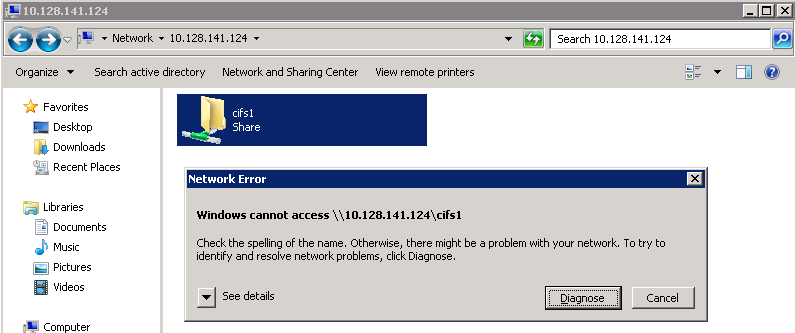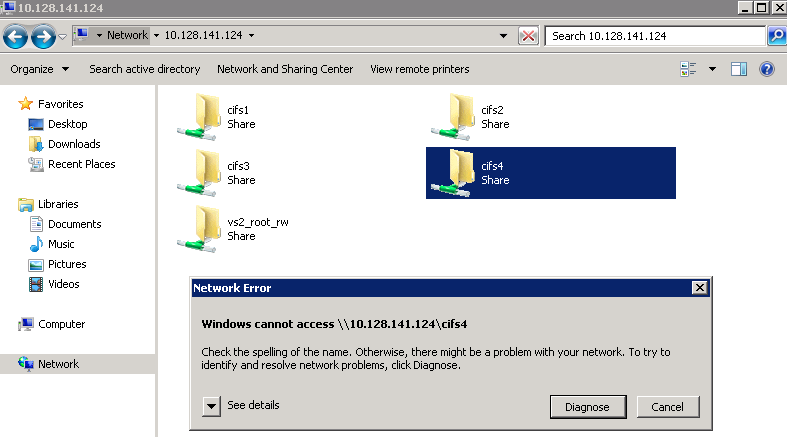Do LS mirrors affect NAS access when new volumes are added?
Applies to
- ONTAP 9
- NFS
- CIFS
- Load-sharing mirror (LS mirror or LSM)
Answer
Yes, newly created CIFS shares and NFS exports may be affected by ls mirrors if it is not updated afterwards, manually or per schedule, as CONTAP-95735: Newly created or junctioned volume is not accessible from NAS protocols explains.
CIFS
- Accessing a new share from a client results in the following error message is displayed:
Windows cannot access <share>. Check the spelling of the name. Otherwise, there might be a problem with your network. To try and identify and resolve network problems, click Diagnose.
- "See details" displays:
Error code: 0x80070035
The network path was not found
- A packet trace will display
Error: STATUS_BAD_NETWORK_NAME

NFS
- For NFS, the newly created export nfs1 is not visible on the client.
Cluster::> volume show -vserver vs_nfs -volume nfs1 -fields junction-path
vserver volume junction-path
------- ------ -------------
vs_nfs nfs1 /nfs1
- From a client:
-bash-3.00# mount -F nfs -o vers=3 10.128.141.122:/nfs1 /mnt/nfs1
nfs mount: 10.128.141.122:/nfs1: No such file or directory
-bash-3.00# mount -F nfs -o vers=3 10.128.141.122:/ /mnt/vs_root
-bash-3.00# cd /mnt/vs_root
-bash-3.00# ls
automount test.txt vol_nfs
Note: nfs1 is not listed here.
Explanation
- In both cases, the root mount point (/) is LS Mirrored:
cm2244a-cn::> snapmirror show
Source Destination Mirror Relationship Total
Path Type Path State Status Progress Healthy
------------- ---- ------------ ------------- -------------- ---------- -------
cm2244a-cn://vs_cifs/vs2_root
LS cm2244a-cn://vs_cifs/vs2_root_ls
Snapmirrored Idle - true
cm2244a-cn://vs_nfs/vs_nfs_root
LS cm2244a-cn://vs_nfs/vs_nfs_root_ls
Snapmirrored Idle - true
Note:
cm2244a-cn://vs_cifs/vs2_rootis the source pathcm2244a-cn://vs_cifs/vs2_root_lsis the destination path
- When a client accesses a volume using NAS, it leverages a file handle. That file handle in ONTAP is the MSID.
- Every volume has a unique MSID, whereas the LS mirror volumes share the same MSID.
Cluster::> volume show -vserver vs_nfs -fields msid
vserver volume msid
------- --------- ----------
vs_nfs automount 2147484731
vs_nfs nfs1 2147484763
vs_nfs nfs2 2147484764
vs_nfs nfs3 2147484765
vs_nfs nfs4 2147484766
vs_nfs vol_nfs 2147484685
vs_nfs vs_nfs_root 2147484684
vs_nfs vs_nfs_root_ls 2147484684
- When a file accesses a volume that is part of an LS mirror set, it uses the MSID.
- The request goes into the cluster and VLDB checks for that MSID.
- Because there are multiple volumes with the same MSID, MSIDs get resolved to the data set ID (DSID) through VLDB calls.
- DSIDs are unique to each volume in the cluster, regardless of LS mirrors:
cm2244a-cn::> volume show -vserver vs_nfs -fields dsid
vserver volume dsid
------- --------- ----
vs_nfs automount 1082
vs_nfs nfs1 1111
vs_nfs nfs2 1112
vs_nfs nfs3 1113
vs_nfs nfs4 1114
vs_nfs vol_nfs 1037
vs_nfs vs_nfs_root 1036
vs_nfs vs_nfs_root_ls 1108
Note:
- All volumes are mounted as
/volname. - Thus, data access results in:
Data Requests --> / --> volname - To ONTAP, a volume is a directory or folder.
- When creating and mounting a volume to /, it appears as a directory to the cluster and clients.
- When a read or write request comes through that path into the N-blade of a node:
- The N-blade first determines if there are any LS mirrors of the volume that it needs to access.
- If there are no LS mirrors of that volume, the read request will be routed to the R/W volume.
- If there are LS mirrors of the volume, preference is given to an LS mirror on the same node as the N-blade that fielded the request.
- If there is no LS mirror on that node, an up-to-date LS mirror from another node is chosen.
- The N-blade first determines if there are any LS mirrors of the volume that it needs to access.
Note: This is why newly created volumes are invisible: since before the LS mirror update, all the requests go to LS Mirror Destination volume, which is Read-Only.
Example:
-bash-3.00# mount -F nfs -o vers=3 10.128.141.122:/ /mnt/vs_root
-bash-3.00# cd /mnt/vs_root
-bash-3.00# ls
automount test.txt vol_nfs
- After updating the LS mirror:
Cluster::> snapmirror update-ls-set -S //vs_nfs/vs_nfs_root
8.3 command
Cluster::> snapmirror update-ls-set -source-path cm2244a-cn://vs_cifs/vs2_root
- It is now visible and accessible:
-bash-3.00# ls
automount nfs1 test.txt vol_nfs
- Alternatively, when attempting access through .admin, VLDB will send the request to the source volume's DSID to allow for write access.
- For NFS, Specify the
.adminpath-bash-3.00# mount -F nfs -o vers=3 10.128.141.122:/.admin /mnt/vs_root
-bash-3.00# cd /mnt/vs_root
-bash-3.00#ls
automount nfs1 test.txt vol_nfs - For CIFS, the difference is not in how a share is accessed, but in what share it is accessed.
- If a share is created for the
.adminpath, then use of that share will cause the client to always have R/W access
- If a share is created for the
- For NFS, Specify the
Cluster::> vserver cifs share create -vserver vs_cifs -share-name vs2_root_rw -path /.admin
- If another new volume 'cifs4' is created and a CIFS share is created upon it without updating the LS Mirror manually:
cluster::> volume show -vserver vs_cifs -fields junction-path
vserver volume junction-path
------- ------ -------------
vs_cifs cifs4 /cifs4
- It still cannot be accessed.

- However, it is visible and accessible from the
.adminpath.

- In order to prevent any potential confusion caused by this, a warning will be displayed, to remind users to update the LS Mirrors after volume creation.
Example:
Cluster::> volume create -vserver vs_nfs -volume nfs2 -aggregate aggr0 -state online -junction-path /nfs2
Warning: You are about to create a volume on a root aggregate. This may cause severe performance or stability problems
and therefore is not recommended. Do you want to proceed? {y|n}: y
[Job 3074] Job succeeded: Successful
Notice: Volume nfs2 now has a mount point from volume vs_nfs_root. The load sharing (LS) mirrors of volume vs_nfs_root
are scheduled to be updated at 9/28/2013 07:05:00. Volume nfs2 will not be visible in the global namespace until
the LS mirrors of volume vs_nfs_root have been updated.
Note: This warning will not be displayed if the new volume is created from the old version of System Manager
Additional Information
A sign the LS mirror might be down, is that after the creation of the new share, when checking the Properties of the share through File Explorer, the Security Tab is missing.
